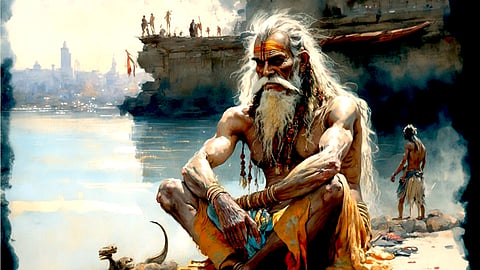- Commentary
- History Vignettes
- Notes on Culture
- Dispatches
- Podcasts
- Indian LanguagesIndian Languages
- Support

WE CAN BEGIN WITH HENRY DAVID THOREAU’S IMMORTAL QUOTE, which has become a universal maxim: the mass of men lead lives of quiet desperation. But there is another class of men and women whom Thoreau left out. These are people who lead lives of quiet tranquility, and history is the best proof of the fact that Bharatavarsha is the unarguable home of the largest population of such men and women. Apart from the countless Rishis and Sadhus and Santas and Munis and Parivrajakas and Yogis, this land has been sanctified by millions of ordinary men and women who purified everyone and everything that were fortunate to come in their contact.
However, the subject of this essay series relates to forgotten and unknown Sadhus and Santas who built no Mathas or institutions. They did not leave behind any school or sect or an inheritance of exclusivity. They were Sadhakas in the most profound sense of the term.
Fortunately, several stalwarts from the era of the Indian Renaissance have published brief and detailed profiles of such Sadhakas for the benefit of posterity. D.V. Gundappa perhaps stands at the forefront. His profiles of obscure monks, mendicants, minstrels, Yogis, and Bairagis published in the Jnapaka-Chitrashale volumes are sumptuous feasts for the soul. The profile of the “mad sanyasi” wandering around the streets of the Chickpet area and the evocative life of Shivapicchai Mudaliar offer solace to the troubled mind and uplift us to exalted realms.
The other Indian Renaissance stalwart who has performed the same service is the iconic Gopinath Kaviraj. Perhaps it is divine coincidence that both Gopinath Kaviraj and D.V. Gundappa were born in the same year: 1887. DVG was a month younger than him. The other similarity between these luminaries was the fact that they were not merely scholars, they were also Sadhakas. For example, Acharya Mysore Hiriyanna led a sublime life suffused with unostentatious Sadhana, inseparable from his study of Sastra. This is also the marked contrast with the “Indic scholars” of the contemporary period. The Sadhana element is precisely what breathes life into all their writings. So, when DVG describes the uplifting life of the unsung rustic Vaidika named Natti Sastri, he generates within us a profound yearning to go back to the Mulabagal of the 19th century and see Natti Sastri in flesh and blood. Gopinath Kaviraj accomplishes the same feat with the same ease.
Starting with this, we present the English adaptations of the life-stories of a few of such Sadhakas narrated by Gopinath Kaviraj. Sri Kaviraj narrates these stories from his personal interactions with the Sadhakas and Sadhus in the first person. As such, we have retained the flavour of the original.
At a personal level, working on this series has been a deeply sanctifying experience and we hope you find them useful and inspirational.
Happy reading!
MY FIRST ACQUAINTANCE WITH THIS GREAT SADHU occurred in the summer of 1923 on the ghats of the sacred Ganga. It is my conjecture that he was a Brahmana from Maharashtra. Even though he used to speak in Hindi with us, it is more accurate to aver that Hindi was not his mother tongue — Marathi was. I didn’t know his exact age but he appeared to be roughly in the range of 50 - 55.
His head was fully shaven and though his body had become frail, it exuded radiance and strength. He used to wander about the ghats in the Digambara state. This is why he was reverentially addressed by everyone as “Naga Baba.” His face radiated undiminished splendour and that permanent smile of joy never left his lips. It appeared as if the brilliant rays of his mental serenity and inner Ānanda were illuminating all four directions. It was evident that he had a good command over both Sanskrit and English when one conversed with him. He permanently lived on the ghats of the Ganga and never moved into the city.
In the blazing Vaiśākha and Jyēṣṭha months, the hard stones of the Varanasi ghats were transformed into scorched slabs emitting the heat of hell. For ordinary people, it is almost impossible to set foot on them. Yet Babaji remains there, in his Digambara state — he sleeps unperturbed, on this dreadful stone-furnace without the slightest discomfort. He lies in the same state on the banks of the sacred Ganga under the unfettered sprawl of the night-sky.
Babaji had another specialty. Both during the day and at night, he never ate any food. Several people have verified this truth by carefully observing him using the stealth of disguise. No one has seen him touch anything that can be called edible. In fact, he has admitted to this in his own words saying, “in my present state, food has no use to me.”
When he takes his sacred ablutions in the purifying waters of the Ganga, he removes his intestines and washes them and puts them back into his body. There have been numerous eyewitnesses to this incredible scene.
Just as how this great Sadhu was a Jñāni, Yogi and Siddha, he was also equanimous in his dealings in worldly life. He never kept anything secret. On the one side, he did not hide his immense store of philosophical and spiritual learning. In the same spirit, he also did not conceal the worldly knowledge that he had accumulated. He freely shared all this knowledge with everyone who came to him, thereby illuminating and enriching their lives. His constant endeavour was to see to it that anyone who came to him had to derive some benefit from his knowledge — no one returned empty-handed. This was Lokasangraha in its purest practical expression.
To be continued
The Dharma Dispatch is now available on Telegram! For original and insightful narratives on Indian Culture and History, subscribe to us on Telegram.
